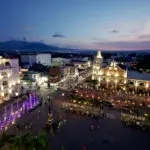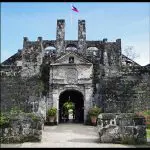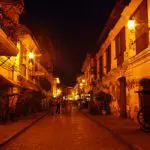During the Christmas holidays, I took advantage of the relatively traffic-free streets to venture on a 2-hour or so drive out to Taal, Batangas after hearing a lot of positive feedback about this relatively unknown place. The word “Taal” by itself is quite well-known mainly because of its namesake volcano but it is also the name of a town nearby. There were two things at the top of my mind that I wanted to see, the first being the Basilica of St. Martin of Tours, said to be the largest church in Asia. The second was the Villavicencio House, one of Taal’s numerous ancestral mansions, and one which I discovered through an old issue of Cebu Pacific’s Smile Magazine.
welcome to taal!
The night before the trip, I scrambled to research more about the town, and to my surprise, there was actually a long list of sights to see there. There are no less than 8 historical-mansions-turned-museums in the quaint old town of Taal. There is of course the Basilica, and there are a couple of other religious sites which can easily take up a full day’s worth of sightseeing. I left my home in Metropolitan Manila at about 7 in the morning, and managed to arrive in Taal around two and a half hours later.
inside the galleria taal – of note is the last photo depicting a bullfight held in manila in the 1950’s
First place we checked out was the Galleria Taal which has a very visible sign by the roadside. The colonial house doubles as a museum of cameras, both old and new. On display were Daguerreotype cameras from the 1800s and a modest collection of Leica cameras among others. There is also an interesting exhibition of old photographs. Entrance fee is at Php 50 and includes a guided tour.
Just across the Galleria is the Apacible House. Also dating back from the 19th century, it is the ancestral home of Don Leon Apacible, Emilio Aguinaldo’s financial officer. The house was later used by his daughter who became the mayor of Taal Town in the early 20th century.
the villavicencio wedding gift house – inside and out
We stopped for lunch over at Taal Bistro, one of the highly recommended eating joints in town. Afterwards, we headed to the Villavicencio Wedding Gift House. In hindsight, this turned out to be the most impressive among the ancestral houses we visited in Taal. We had to book in advance (# 0917 – 8970363) to be allowed inside. Compared to many of the ancestral houses we visited, the Villavicencio House had been restored to an extent, and guests can also choose to stay for the night if they wish (rates start from around Php 3,000 per night). A hallmark of the house are the bright yellow walls with multi-colored floral accents which makes this not so humble abode a photographer’s delight.
the other villavicencio house
A stone’s throw away is another Villavicencio House. Though restoration works here were less evident, this house was far more historical. Personalities from the Philippine revolution such as Emilio Aguinaldo once stayed there and plans for the revolution were made from no less than the house’s elongated dining table. The tour came with a short video presentation detailing the life and times of the house’s original occupants.
the taal basilica
It was already mid-afternoon by the time we left the fourth and last ancestral house of this trip. We stopped by the Basilica of St. Martin de Tours. Said to be the largest church in Asia, its rectangular facade is quite unlike the triangular-shaped facade of most churches in the country. The Taal Church, in its present location, had been in existence since the 16th century. But a series of earthquakes have led to at least 2 incidents of church destruction. The current design dates back from the 19th century and was designed by Spanish architect Luciano Oliver. For a town of just 50,000 inhabitants, I must say the church design is pretty grand, and a bit similar to the churches in Europe.
the casa real of taal
The church overlooks the town plaza – a small park – from where the municipal hall stands on the opposite side. It dates back from the original Casa Real built in the 1800’s which served as the town’s administration center during the Spanish period.
our lady of casaysay shrine
Before leaving town, we stopped by the Our Lady of Casaysay Shrine. It’s a bit farther from the other attractions but nevertheless still walkable (around 15 to 20 minutes). Made of coral stones, the building dates back from the 17th century after the image of the Virgin Mary was caught in the fishnet of a local fisherman. The building also doubles as a church – I witness a session of the Sunday mass during the first time I dropped by.
I didn’t have much time left after that, and unfortunately had to leave town by late afternoon. There were still quite a few things to see though – at least 4 other ancestral homes I didn’t manage to visit. But I did manage to see what I came for. And given its relatively short distance from Manila, a repeat visit could very well be in order!























Interesting photo on the old bullfighting photograph. I’ve read just recently that bullfighting in Manila during the Spanish period wasn’t really as thrilling because for some reason, the local bulls were less vicious than the ones found in Europe or the Americas. I’m surprised that one was still held as late as the 1950s.
Next time you come to Taal Batangas you might as well try to take home some of their delicacies. Most specially the Tapa and Longganisa. BTW, we are selling those delicacies in the Taal Public Market
Thanks for the tips – I never did get to try the tapa and longganisa there!
I’m curious about the bullfight too. If you come across more research on this — like where exactly was this held — pls blog about it. Btw, I wish I can take photos like you do. Been to Taal, but these photos are stunning!
Thanks for your kind words! Am intrigued by the bullfights too… I didn’t know it was ever in vogue in the Philippines!
whats the fastest and easiest route to get there from metro manila? private car
We are planning to visit Taal this weekend. Your description of the place excites us. Can’t wait to see its beauty.
Hi Donn, glad it helped 🙂
Enjoy!